No products in the cart.
NEWS
Discovering the Best Types of Tomatoes for Your Garden
Stepping into the world of tomato gardening reveals a dazzling array of choices. From tiny pops of sweetness to hefty slicers perfect for sandwiches, the sheer variety can be overwhelming. How do you navigate this colorful spectrum and choose the tomato varieties that will thrive in your garden and meet your culinary desires? The ideal tomato for you depends on several factors: how you plan to use your harvest, the climate you garden in, the amount of space you have available, and even your preference for color and flavor. Whether you dream of canning batches of homemade sauce, enjoying sun-warmed fruits right off the vine, or showcasing unique colors in your salads, understanding the different types of tomatoes available is the first step to a successful and rewarding growing season. As experts in supporting your plant-growing journey, Biogarden.asia is here to guide you through the diverse world of tomato varieties.
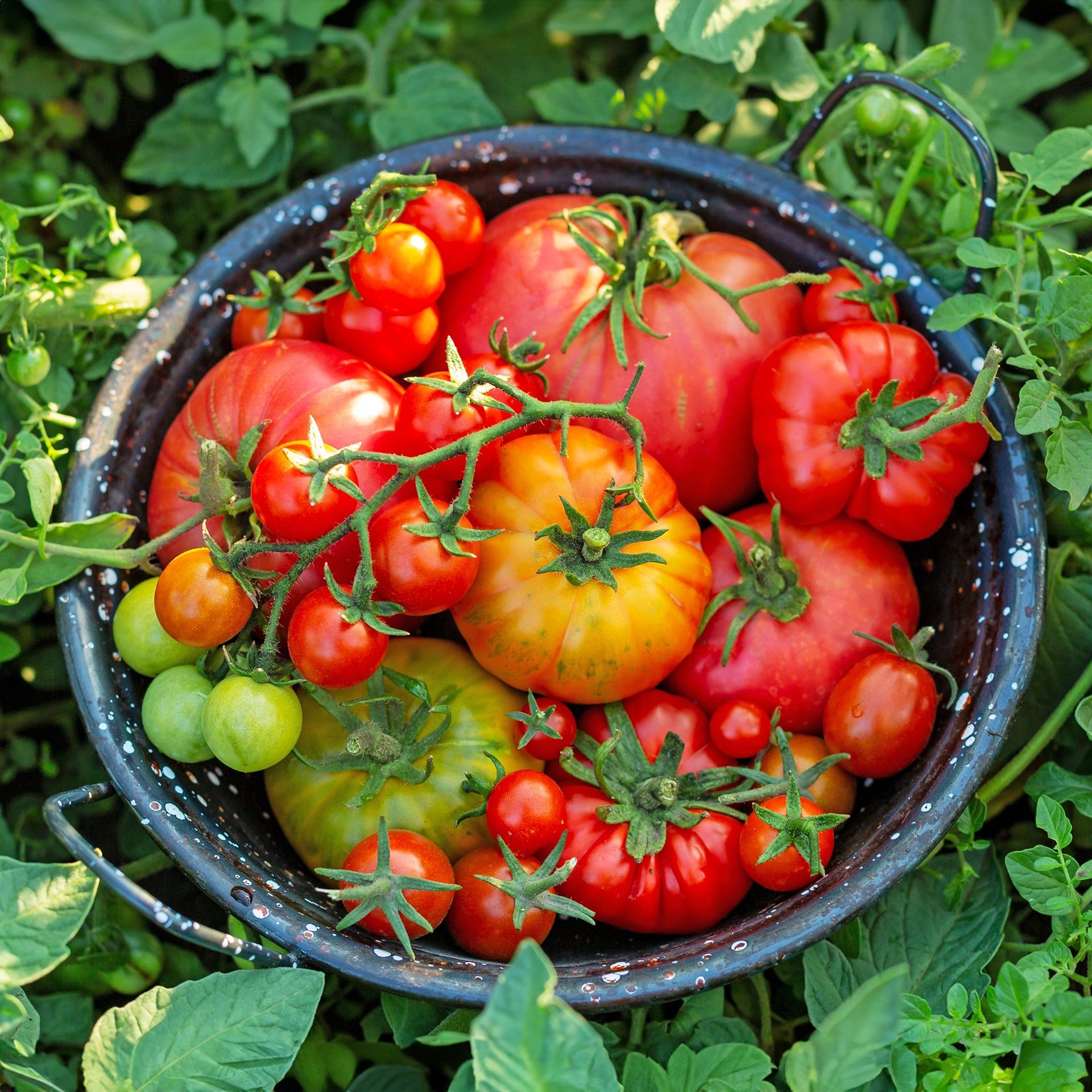 Freshly harvested ripe tomatoes of various colors collected in a colander in a vegetable garden
Freshly harvested ripe tomatoes of various colors collected in a colander in a vegetable garden
Categorizing Tomatoes by Growth Habit: Determinate vs. Indeterminate
One of the most fundamental distinctions among tomato plants relates to their growth pattern. All tomato plants fall into one of two main categories: determinate or indeterminate. Understanding this difference is key to planning your garden layout and knowing when to expect your harvest.
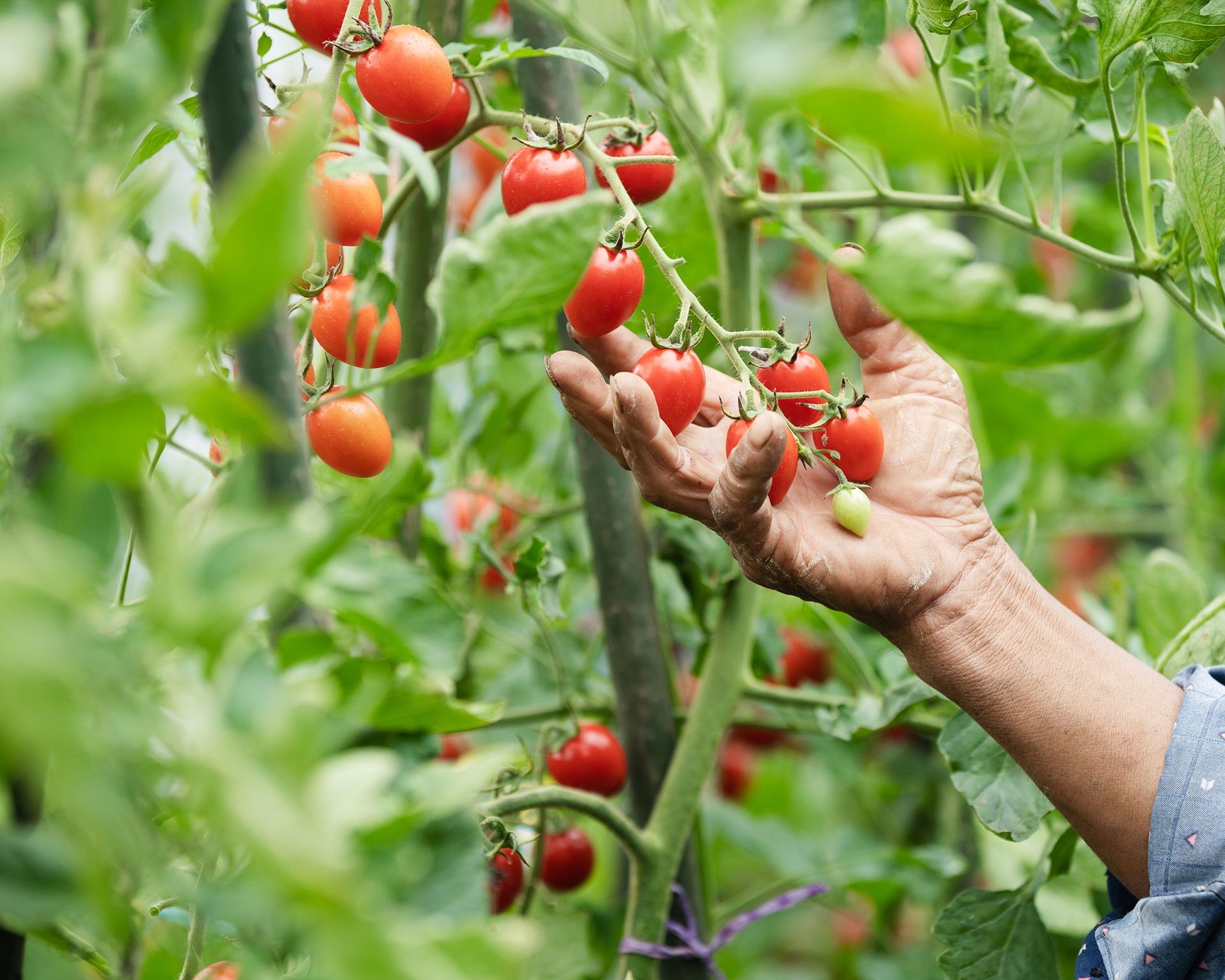 A gardener examines a tomato vine, illustrating the different growth habits like determinate and indeterminate types
A gardener examines a tomato vine, illustrating the different growth habits like determinate and indeterminate types
Determinate (Bush) Tomatoes
Often referred to as “bush tomatoes,” determinate varieties exhibit a more controlled, compact growth. They typically reach a mature height of about 3 to 4 feet (1 to 1.2 meters) and stop growing once fruit sets on the terminal bud. This bushy habit makes them exceptionally well-suited for smaller gardens, raised beds, or container planting. A defining characteristic of determinate tomatoes is their concentrated fruiting period. Most of the tomatoes on the plant ripen around the same time, usually over a two-week window. This makes them ideal if you need a large batch of tomatoes all at once, such as for canning, making sauces, or drying. They are also a good choice for gardeners with shorter growing seasons.
Indeterminate (Vining) Tomatoes
Conversely, indeterminate tomatoes are often called “vining” or “cordon” types because they grow continuously throughout the season, often reaching heights of 6 to 20 feet (2 to 6 meters) or more if left unchecked. These vigorous growers require substantial support, such as sturdy stakes or tomato cages, to manage their vertical habit. Unlike their determinate cousins, indeterminate tomatoes produce fruit continuously from the onset of ripening until the first hard frost. If you prefer a steady supply of fresh tomatoes to pick every few days for salads, slicing, or snacking throughout the summer and fall, indeterminate varieties are your best bet. While they require more space and support, their prolonged harvest can be highly rewarding.
Heirloom vs. Hybrid: Breeding and Characteristics
Beyond growth habit, tomatoes are also broadly categorized based on how their seeds are developed and passed down: heirloom or hybrid. Each category offers distinct advantages and characteristics that influence flavor, disease resistance, and seed saving potential.
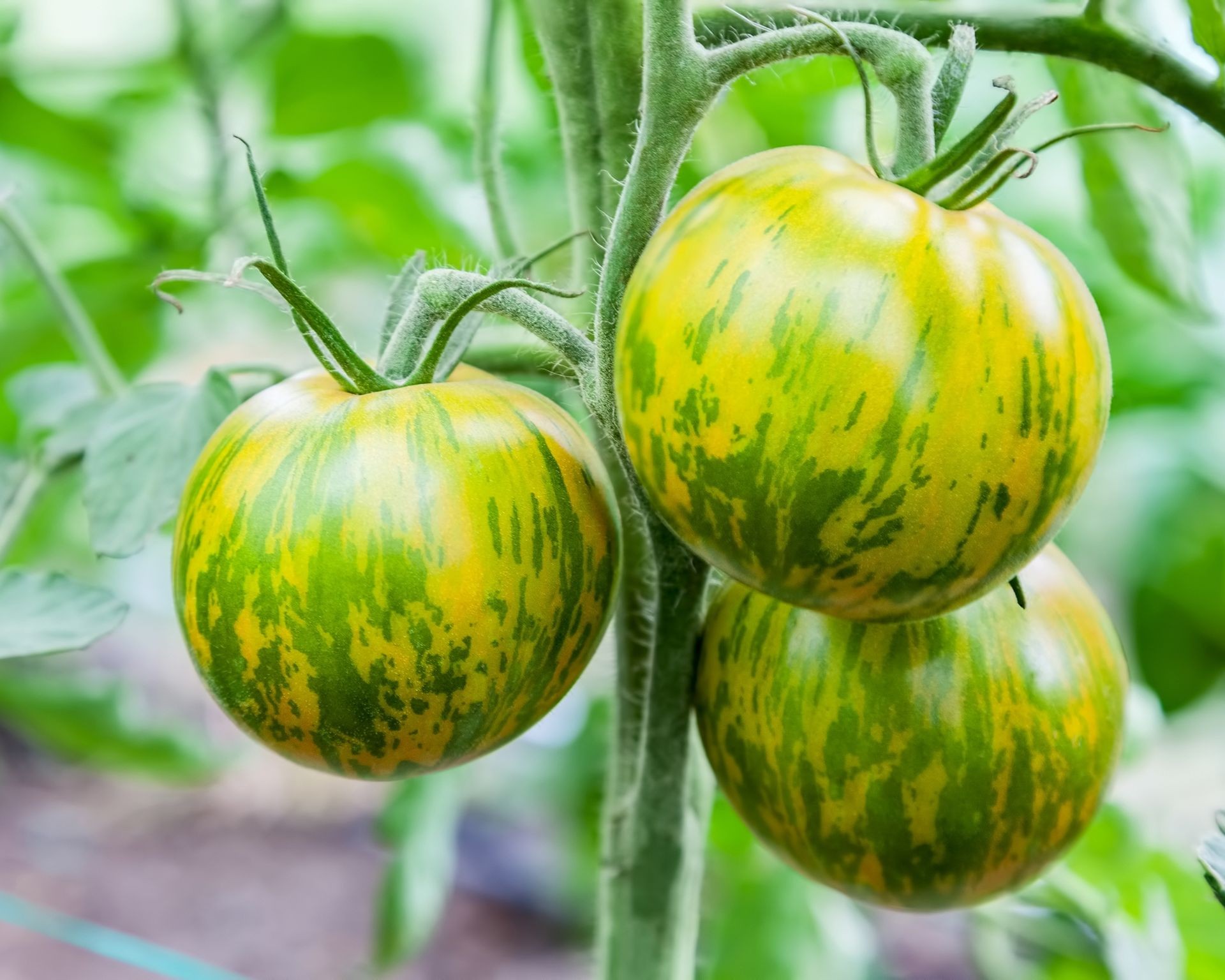 Striking Green Zebra heirloom tomatoes ripening on the vine, showcasing their unique striped appearance
Striking Green Zebra heirloom tomatoes ripening on the vine, showcasing their unique striped appearance
Heirloom Tomatoes
Heirloom tomatoes are open-pollinated varieties that have been grown and passed down through generations, typically for at least 50 years. They are celebrated for their incredible diversity in shape, size, and, most notably, color and flavor. You can find heirlooms in shades of green, purple, black, yellow, and even with stripes or mottled patterns. Gardeners and chefs often praise heirlooms for their complex, intense, and often superior flavor compared to many modern hybrids. Because they are open-pollinated, seeds saved from an heirloom tomato will produce plants with the same characteristics as the parent plant, allowing gardeners to preserve favored varieties year after year. However, heirlooms can be more susceptible to common tomato diseases and may not yield as heavily or store as long as some hybrid counterparts, often having a shorter shelf life of just 1-7 days. Popular heirloom examples include Cherokee Purple, Brandywine, Green Zebra, Yellow Pear, and Black Krim.
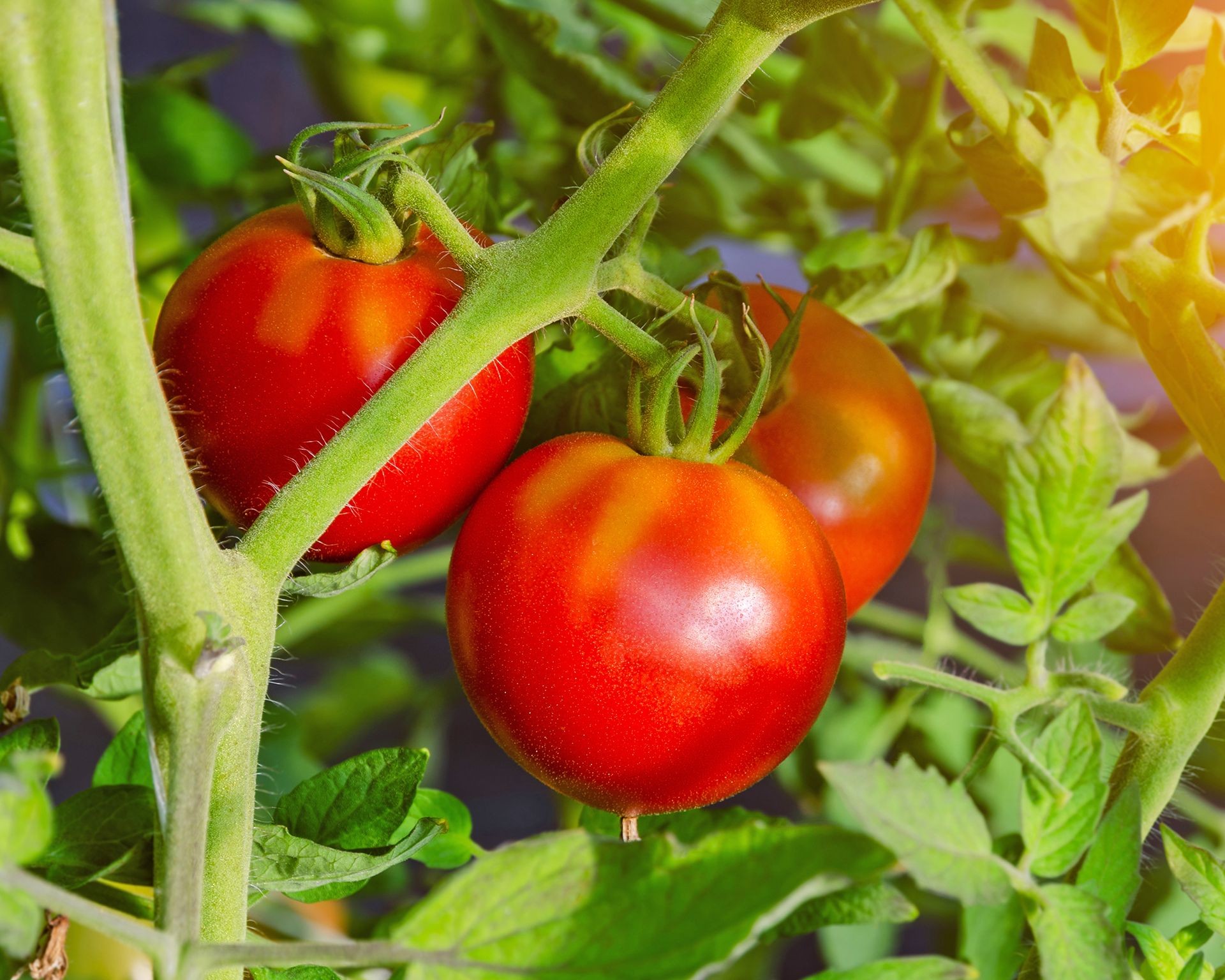 Healthy Celebrity hybrid tomatoes growing on the vine, representing consistency and disease resistance
Healthy Celebrity hybrid tomatoes growing on the vine, representing consistency and disease resistance
Hybrid Tomatoes
Hybrid tomatoes are the result of carefully controlled cross-pollination between two parent varieties selected for desirable traits. This selective breeding allows plant developers to create tomatoes with enhanced characteristics, such as improved disease and pest resistance, more consistent fruit size and shape, and better shipping and storage capabilities due to thicker skins. Many commercial tomatoes are hybrids because of these reliable traits. While hybrids often prioritize yield and resilience, some gardeners feel they may lack the depth and complexity of flavor found in many heirloom varieties. A key difference is that seeds saved from a hybrid tomato will not reliably produce plants identical to the parent; they will likely revert to traits from earlier generations. Therefore, gardeners must purchase new hybrid seeds each year. Examples of popular hybrid tomatoes include Big Boy, Early Girl, Celebrity, and Better Bush.
Exploring Tomato Types by Size, Shape, and Use
Tomatoes also come in various forms, each best suited for specific culinary applications. Understanding these common types will help you choose varieties that match your cooking and eating habits.
Globe Tomatoes
These are the familiar round tomatoes typically found in grocery stores. Globe tomatoes are plump, juicy, and medium-sized, making them the quintessential slicing tomato perfect for sandwiches and burgers. They often have a balanced, relatively mild flavor profile. Many globe varieties are hybrids bred for uniformity and durability, with thick skins and firm flesh suitable for fresh consumption or cooking. Examples include Better Boy, Early Girl, and Super Bush.
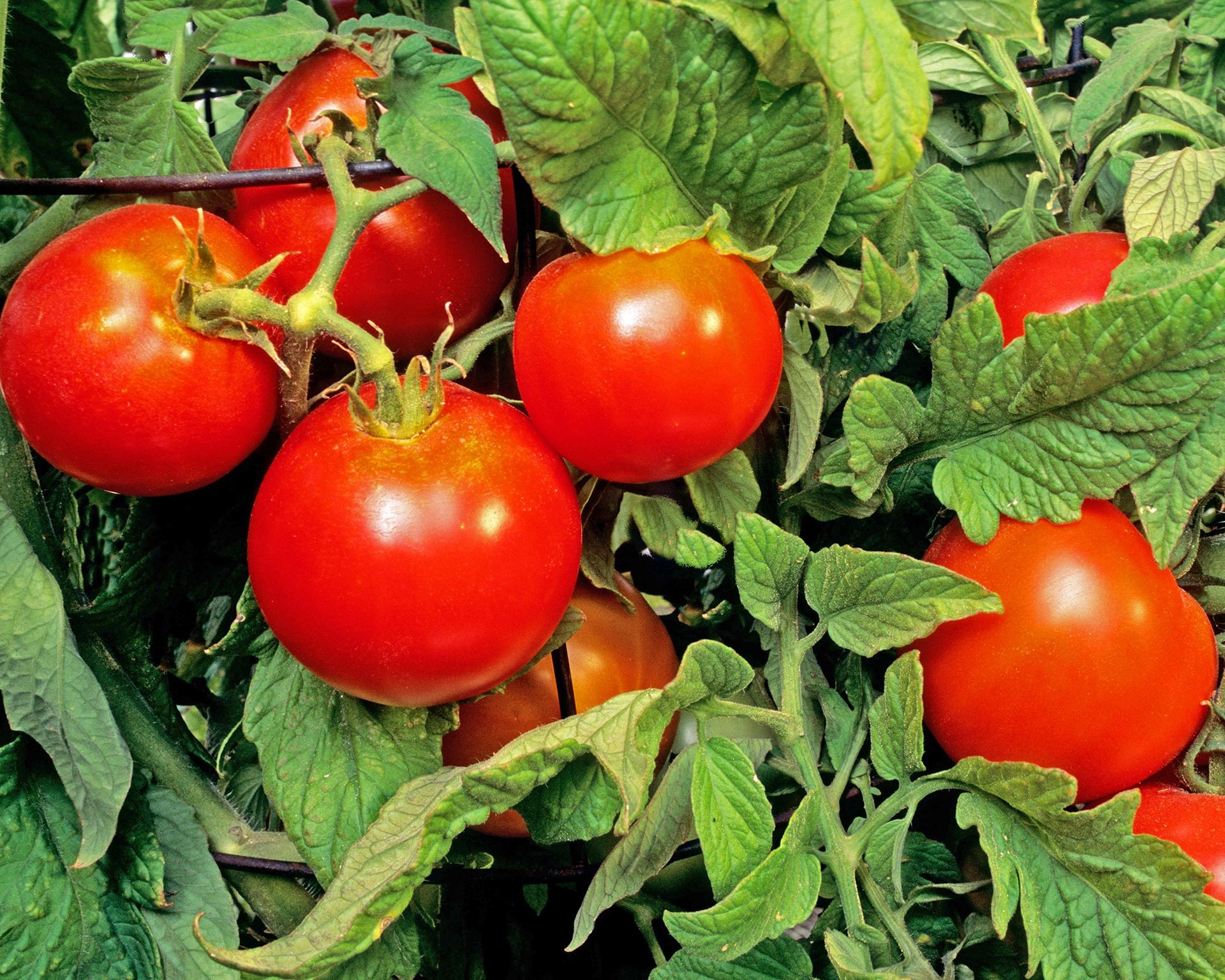 Early Girl globe tomatoes ripening on the vine, typical of the round, slicing varieties found in markets
Early Girl globe tomatoes ripening on the vine, typical of the round, slicing varieties found in markets
Cherry, Grape, and Pear Tomatoes
These are the small-fruited members of the tomato family, ideal for snacking, salads, or roasting. Cherry tomatoes are generally round and burst with sweet, juicy flavor. Grape tomatoes are slightly smaller and more oblong with a meatier texture. Pear tomatoes, often heirloom varieties, are distinctively pear-shaped, offering a mild sweetness and tender texture, great for salads or as a garnish. All three types are fantastic eaten fresh right off the vine and are popular choices, especially for introducing children to gardening and healthy eating. Examples include Sun Gold, Supersweet 100, and Isis Candy for cherry types; Jelly Beans and Golden Sweet for grape types; and the well-known Yellow Pear heirloom.
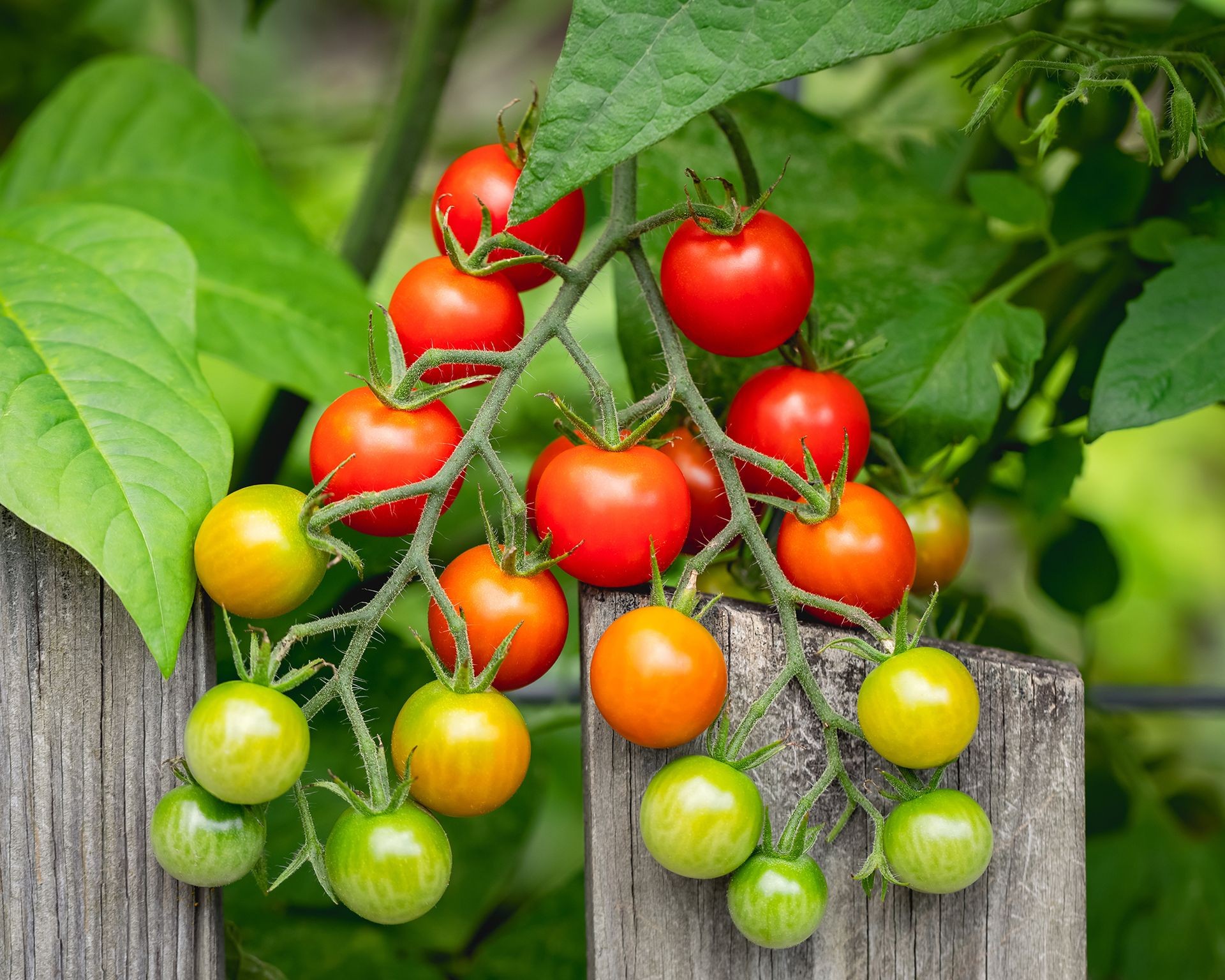 A bountiful cluster of Supersweet 100 cherry tomatoes, highlighting their small size and suitability for snacking
A bountiful cluster of Supersweet 100 cherry tomatoes, highlighting their small size and suitability for snacking
Plum (Paste) Tomatoes
Plum tomatoes, also widely known as paste tomatoes, are the go-to choice for making sauces, pastes, and canning due to their rich flavor, meaty texture, and lower water content compared to slicing tomatoes. These oval or elongated tomatoes cook down beautifully, concentrating their flavor. The most famous varieties are Roma and San Marzano. Romas are versatile, used fresh or cooked, and commonly found in markets. San Marzano tomatoes, originating from Italy, are highly prized for their exceptional flavor and texture when canned and are a staple in classic Italian cuisine. Other examples include Big Mama and Amish Paste.
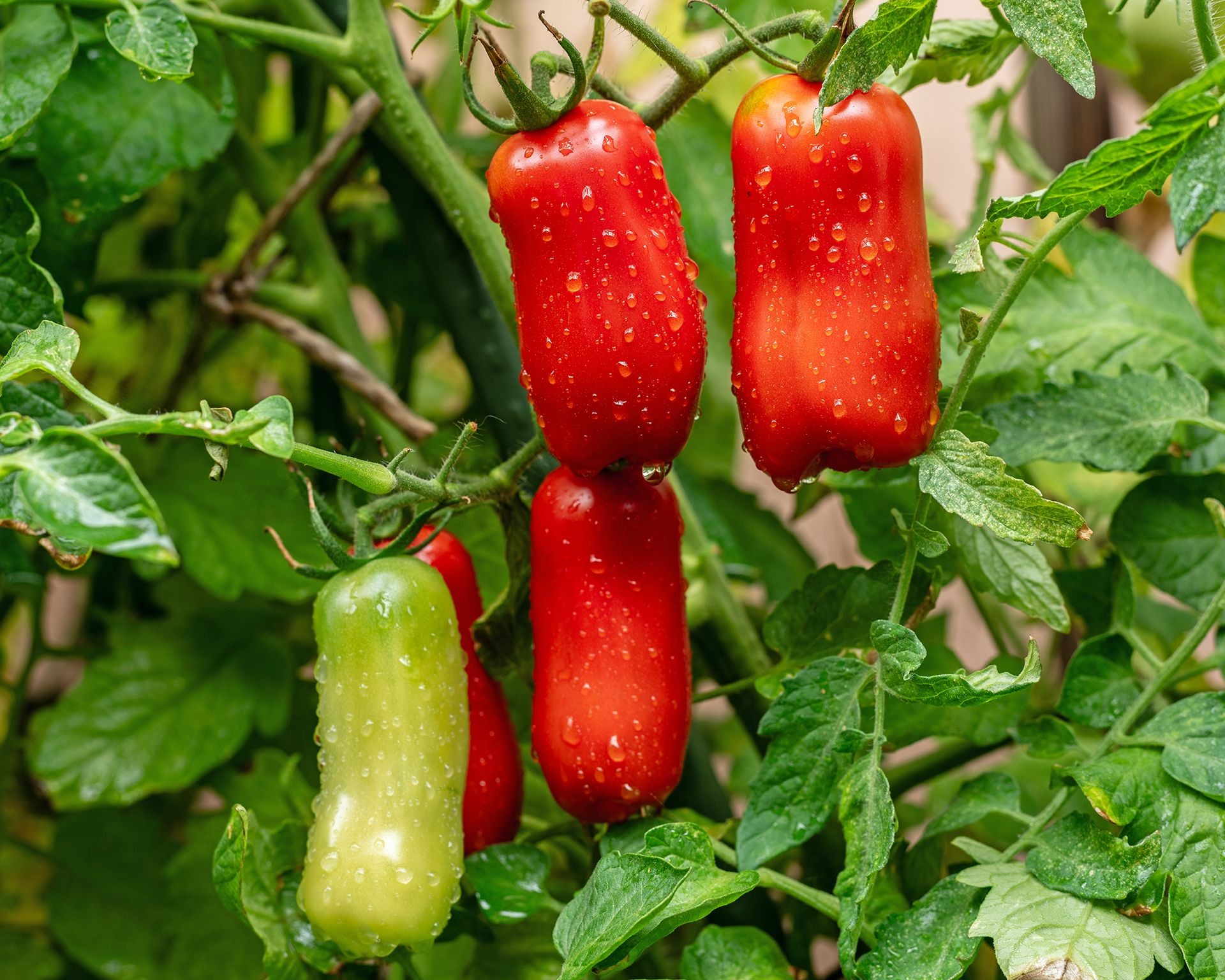 Classic San Marzano plum tomatoes on the vine, showing their elongated shape ideal for sauces and canning
Classic San Marzano plum tomatoes on the vine, showing their elongated shape ideal for sauces and canning
Beefsteak Tomatoes
Beefsteak tomatoes are the giants of the tomato world, known for their impressive size and often irregular shape. These large, sometimes ribbed fruits are celebrated for their excellent, balanced flavor, making them a top choice for home gardeners in North America. Their substantial size and meaty slices make them perfect for stacking high on sandwiches, burgers, or incorporating into fresh salsas. Beefsteak varieties can be found among both heirloom and hybrid types and generally mature later in the season than smaller varieties. Popular beefsteak examples include Big Rainbow, Brandywine, Cherokee Purple, and Mountain Fresh Plus.
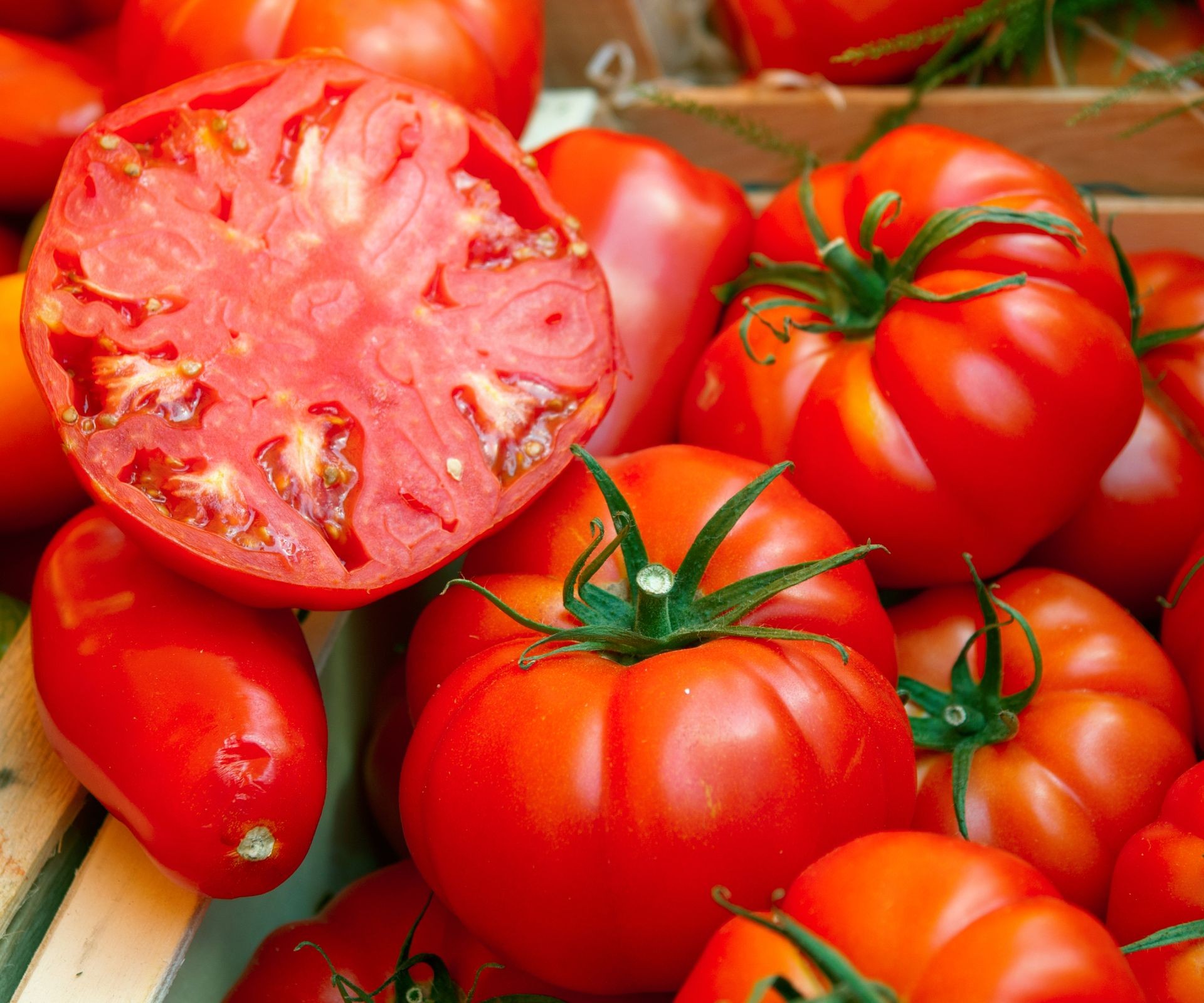 A large red beefsteak tomato sliced in half next to whole ones, demonstrating their size and meaty texture for slicing
A large red beefsteak tomato sliced in half next to whole ones, demonstrating their size and meaty texture for slicing
Exploring the Rainbow: Health Benefits of Colored Tomatoes
While traditional red tomatoes, rich in the powerful antioxidant lycopene, are a health staple, the world of colored tomatoes offers even more nutritional diversity. Incorporating tomatoes of different hues into your diet is a simple way to boost your intake of various vitamins and antioxidants.
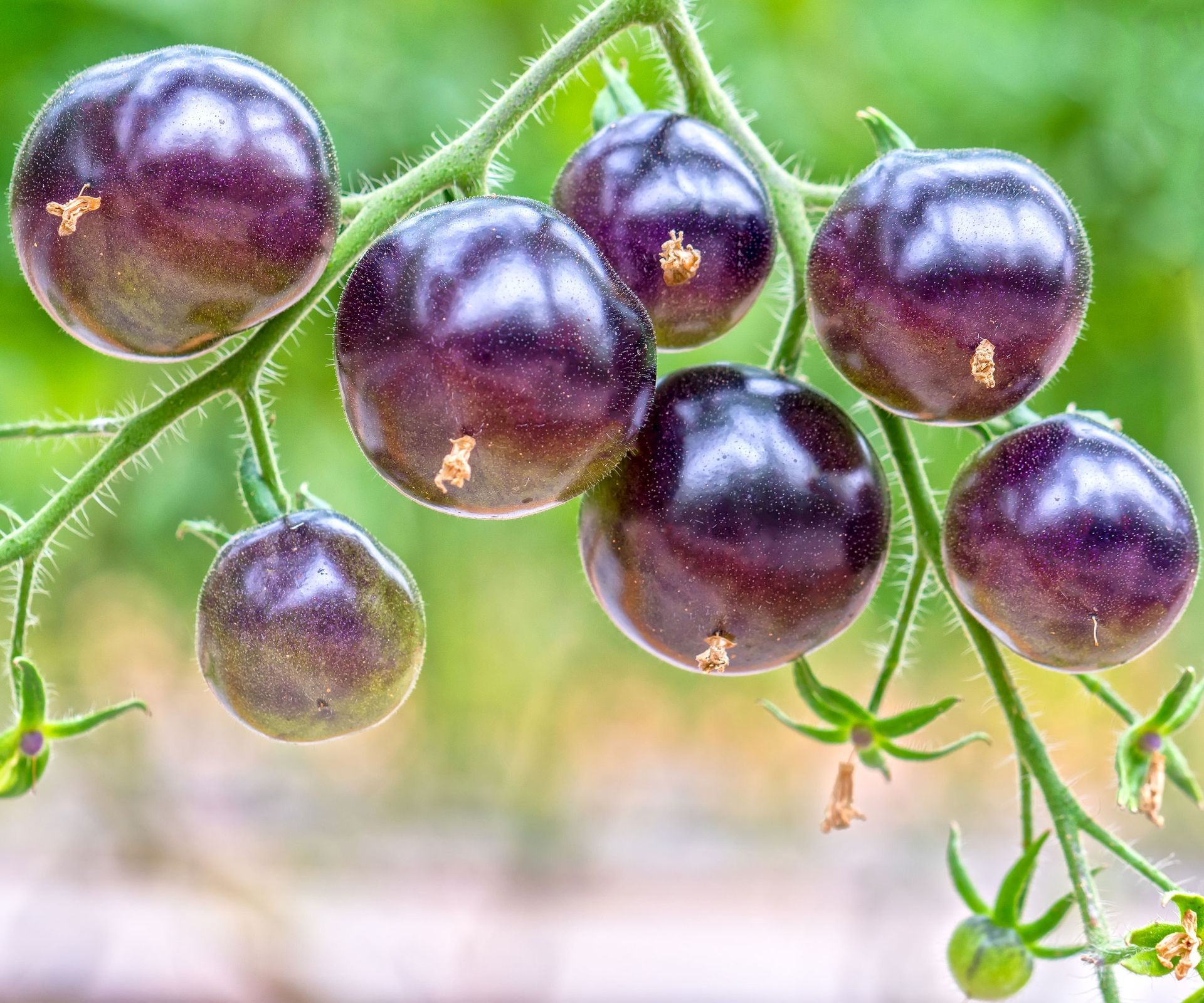 Striking Indigo Rose purple tomatoes growing on the stem, showcasing the vibrant colors available beyond traditional red
Striking Indigo Rose purple tomatoes growing on the stem, showcasing the vibrant colors available beyond traditional red
Yellow tomatoes, for instance, tend to be higher in folate and niacin. Green tomatoes, whether unripe red varieties or types that stay green when mature like ‘Green Zebra’, are excellent sources of Vitamin C. Purple and black tomatoes are particularly noted for their high levels of anthocyanins, another group of potent antioxidants also found in blueberries and blackberries. By growing and eating a variety of tomato colors, you contribute to a broader spectrum of health benefits. Tomatoes in general are fantastic for supporting immune function, fighting free radicals, contributing to healthy blood pressure and cholesterol levels, aiding digestion, and even supporting eye health. The options for vibrant, healthy, and delicious colored tomatoes are vast, including varieties like Thai Pink Egg, Hawaiian Pineapple, Yellow Stuffer, Ghost Cherry, Green Moldovan, and Black Ethiopian.
Tomatoes for Small Spaces: Dwarf & Patio Varieties
Don’t have a sprawling garden? No problem! Many tomato varieties have been developed specifically for limited spaces, container gardening, patios, and balconies.
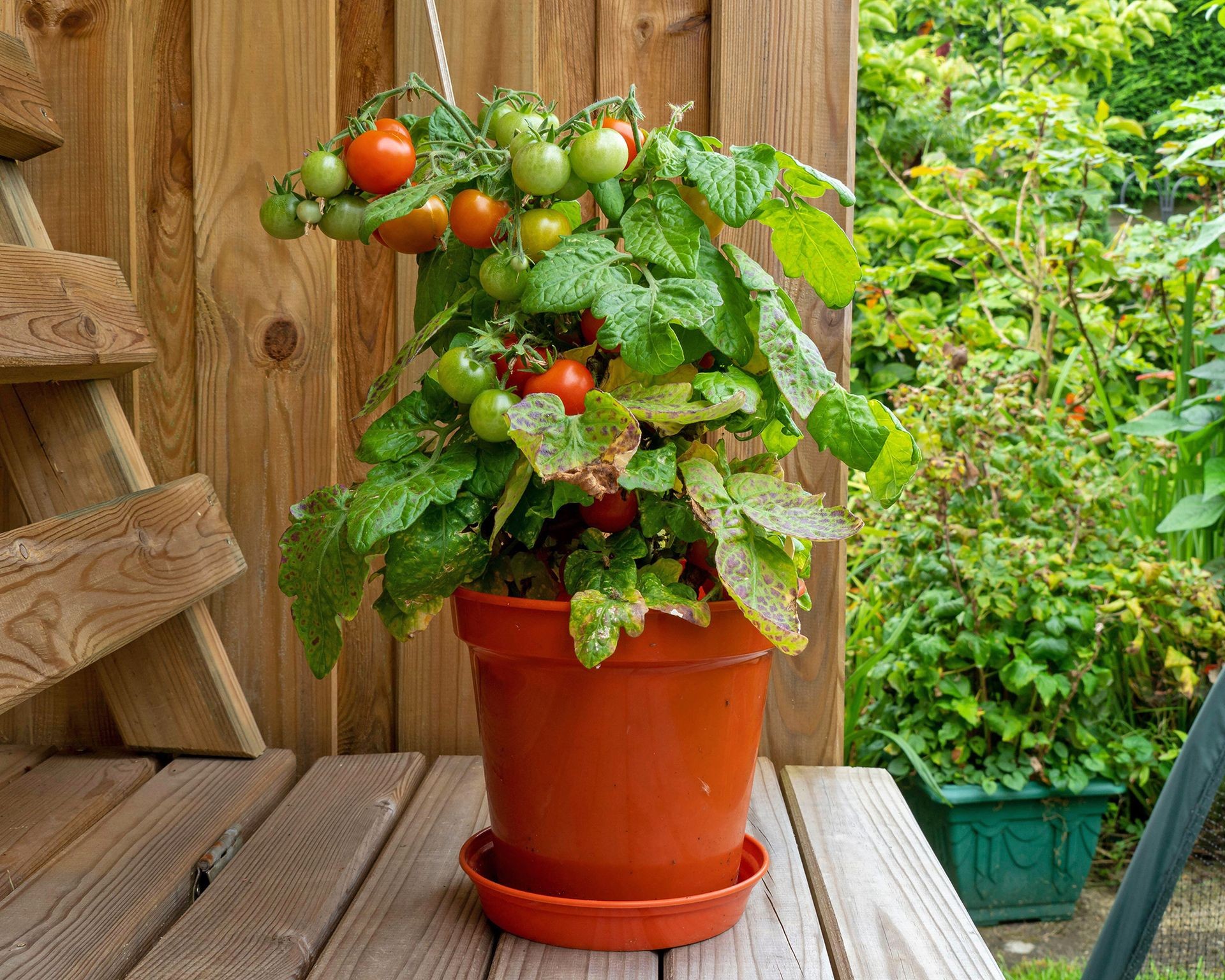 Compact Red Robin determinate tomatoes thriving in a container garden, perfect for small spaces and patios
Compact Red Robin determinate tomatoes thriving in a container garden, perfect for small spaces and patios
Dwarf and patio tomatoes are characterized by their compact size, typically growing between 2 to 5 feet (60 to 150 cm) tall. Many of these are determinate types, offering their yield in a concentrated burst, but their manageable size is their key feature. They require less support than larger indeterminate varieties, though some still benefit from a small cage or stake. Many dwarf and patio cultivars are also bred for disease resistance, adding to their appeal for home growers. Examples include Banana Toes and Purple Heart among dwarf varieties, and Patio Choice Yellow Bush Cherry and Patio F Hybrid for patio cultivars.
The Ancestors: Wild and Currant Tomatoes
For a taste of tomato history and resilience, consider exploring wild or currant tomatoes. These tiny-fruited plants are closely related to the ancient ancestors of our modern cultivated tomatoes.
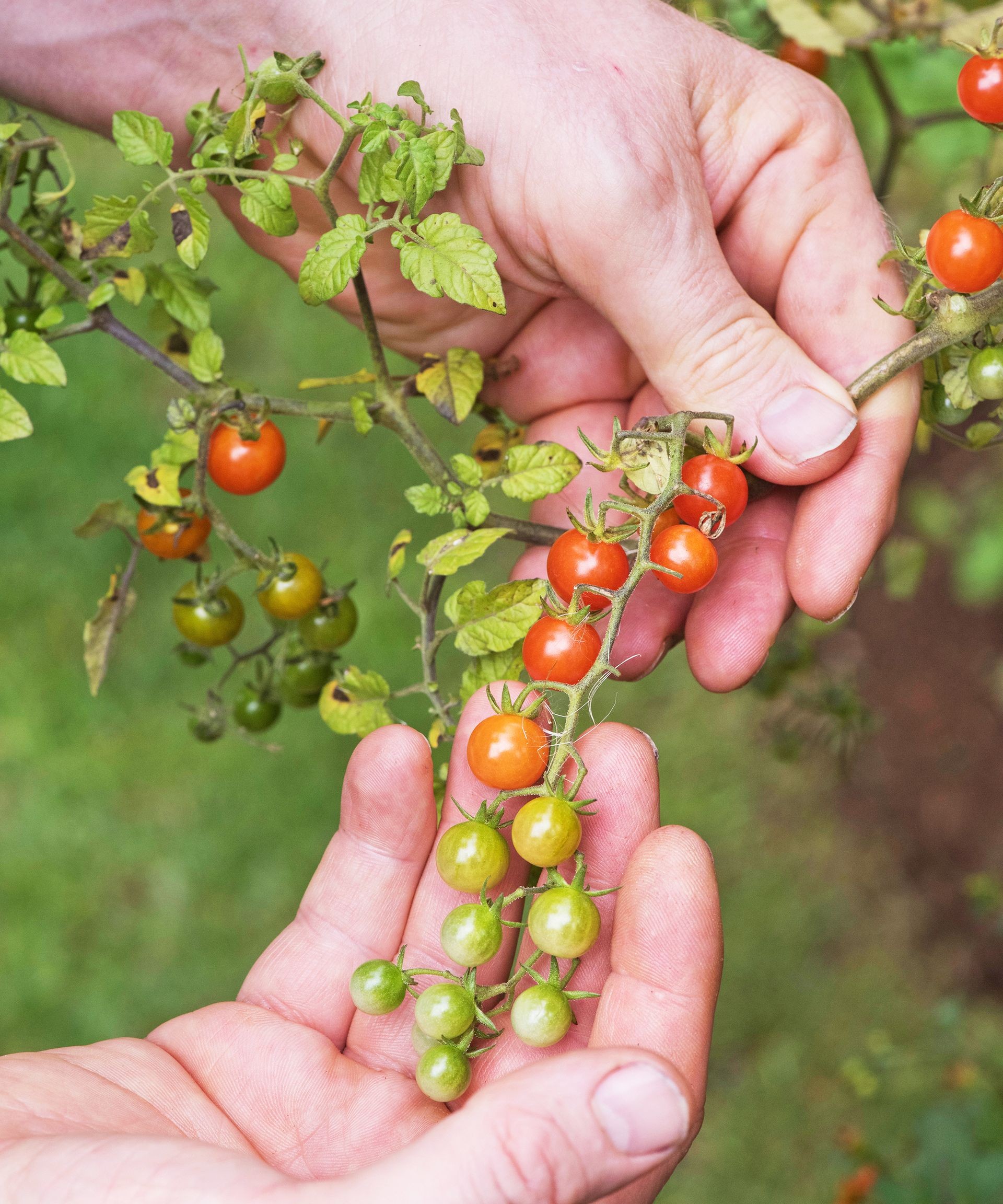 A gardener examines tiny wild tomatoes or currant tomatoes, highlighting their small size and resilient nature
A gardener examines tiny wild tomatoes or currant tomatoes, highlighting their small size and resilient nature
Originating from regions that were sometimes less than hospitable, these types are known for their low-maintenance nature and impressive disease resistance. They are remarkably adaptable to different soil conditions. While their fruit is significantly smaller than even cherry tomatoes, they can be prolific producers of intensely flavored berries. If you’re looking for a resilient, easy-to-grow tomato with a connection to its wild roots, look for legitimately sourced cultivars like Currant Tomato or Matt’s Wild Cherry.
Choosing the best tomatoes to grow is a fun and rewarding process. By considering factors like the plant’s growth habit, how you plan to use the fruit, the space you have, and the flavors and colors you desire, you can select varieties that are not only productive but also bring joy to your garden and your table. Whether you prioritize disease resistance, unique flavors, suitability for containers, or a continuous harvest, there is a tomato type perfectly suited for you. We encourage you to explore the options and find the varieties that inspire you most. Find the seeds and supplies you need to start your tomato-growing adventure at Biogarden.asia and experience the satisfaction of harvesting your own delicious tomatoes!



